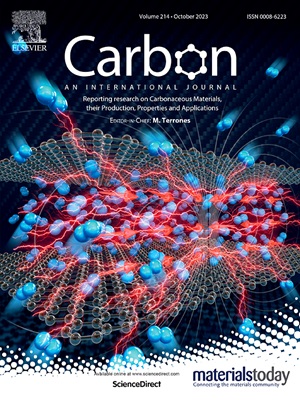Persulfate activation over B, N co-doped carbon nanotubes encapsulated with Fe3C (Fe3C@BN-CNT-x) studied for degradation of Rhodamine B
IF 10.5
2区 材料科学
Q1 CHEMISTRY, PHYSICAL
引用次数: 0
Abstract
Herein, B, N co-doped carbon nanotubes encapsulated with Fe3C (Fe3C@BN-CNT-x) were synthesized via a one-step pyrolysis process, which is used to activate peroxymonosulfate (PMS) for the degradation and removal of water-soluble dye pollutants. The morphology and crystalline phase structure, elemental composition, specific surface area, pore structure, and defects of Fe3C@BN-CNT-x were subjected to comprehensive analysis and investigation through the use of scanning electron microscopy (SEM), transmission electron microscopy (TEM), X-ray diffraction (XRD), X-ray photoelectron spectroscopy (XPS), N2 isothermal adsorption and desorption curves, Raman spectroscopy. Fe3[email protected], the best sample, displayed the largest specific surface area, the highest ratio of Fe-Nx and BC3 centers, and most abundant defect sites. As a result, Fe3[email protected] shows the fastest and highest efficient removal of Rhodamine B (RhB), achieving 100 % degradation efficiency within 8 min. The degradation rate constant of RhB over Fe3[email protected] is as high as 0.531 min−1, which is about 5 times that of Fe3C@N-CNT. Free-radical quenching experiment and electron paramagnetic resonance (ESR) spectroscopy, as well as electrochemical voltammetry, identify the non-radical 1O2 as the dominant reactive species. Other free-radicals, such as SO4•−, •OH, and •O2−, play a minor role, while electron transfer mechanism was not a significant factor in the process of degradation.
研究了Fe3C包封的B, N共掺杂碳纳米管(Fe3C@BN-CNT-x)对罗丹明B的过硫酸盐活化降解
本文采用一步热解法合成了Fe3C包封的B, N共掺杂碳纳米管(Fe3C@BN-CNT-x),并利用该工艺激活过氧单硫酸盐(PMS)降解和去除水溶性染料污染物。利用扫描电镜(SEM)、透射电镜(TEM)、x射线衍射(XRD)、x射线光电子能谱(XPS)、N2等温吸附和解吸曲线、拉曼光谱等对Fe3C@BN-CNT-x的形貌和晶相结构、元素组成、比表面积、孔隙结构、缺陷等进行了综合分析和研究。Fe3[email protected]样品比表面积最大,Fe-Nx和BC3中心比例最高,缺陷位点最多。结果表明,Fe3[email protected]对罗丹明B (Rhodamine B, RhB)的去除速度最快、效率最高,在8 min内达到100%的降解效率,RhB对Fe3[email protected]的降解速率常数高达0.531 min−1,约为Fe3C@N-CNT的5倍。自由基猝灭实验、电子顺磁共振(ESR)光谱以及电化学伏安法均证实非自由基1O2为主要反应物质。其他自由基,如SO4•−、•OH和•O2−,在降解过程中起次要作用,而电子传递机制在降解过程中不是一个重要的因素。
本文章由计算机程序翻译,如有差异,请以英文原文为准。
求助全文
约1分钟内获得全文
求助全文
来源期刊

Carbon
工程技术-材料科学:综合
CiteScore
20.80
自引率
7.30%
发文量
0
审稿时长
23 days
期刊介绍:
The journal Carbon is an international multidisciplinary forum for communicating scientific advances in the field of carbon materials. It reports new findings related to the formation, structure, properties, behaviors, and technological applications of carbons. Carbons are a broad class of ordered or disordered solid phases composed primarily of elemental carbon, including but not limited to carbon black, carbon fibers and filaments, carbon nanotubes, diamond and diamond-like carbon, fullerenes, glassy carbon, graphite, graphene, graphene-oxide, porous carbons, pyrolytic carbon, and other sp2 and non-sp2 hybridized carbon systems. Carbon is the companion title to the open access journal Carbon Trends. Relevant application areas for carbon materials include biology and medicine, catalysis, electronic, optoelectronic, spintronic, high-frequency, and photonic devices, energy storage and conversion systems, environmental applications and water treatment, smart materials and systems, and structural and thermal applications.
 求助内容:
求助内容: 应助结果提醒方式:
应助结果提醒方式:


